Information Age 2000 - present




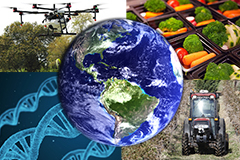


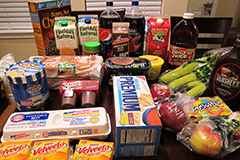

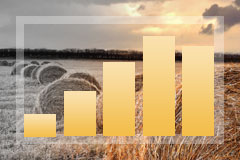

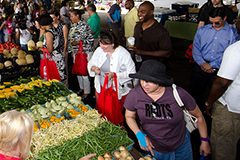








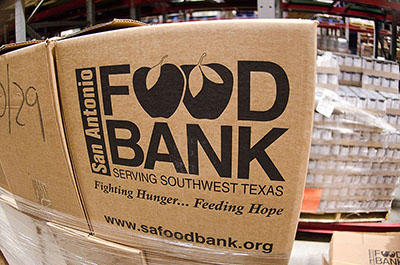



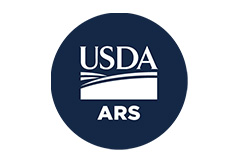


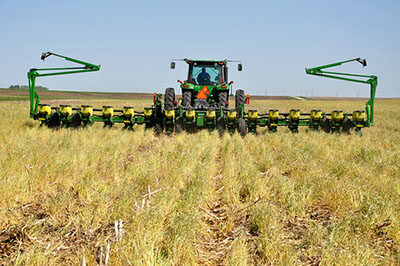

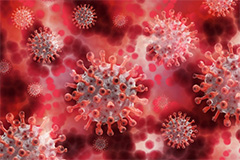
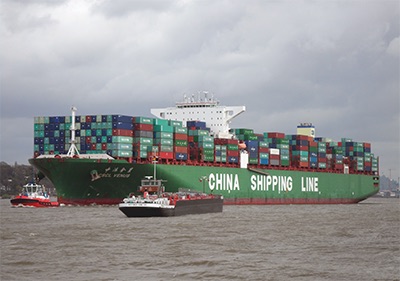






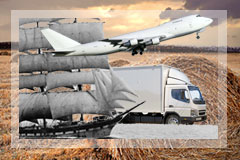

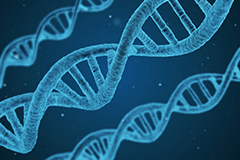

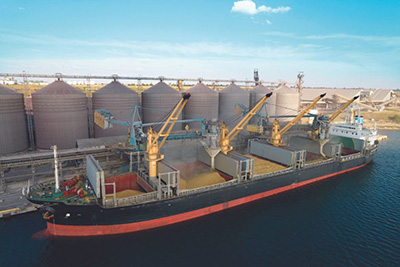

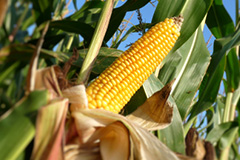





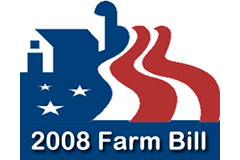



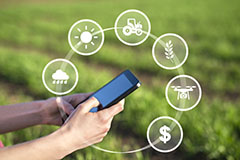
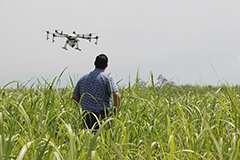







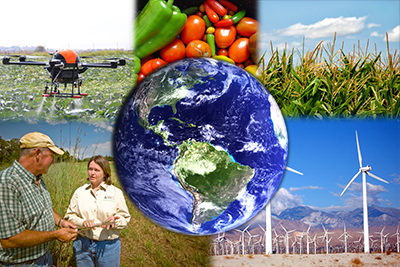

What would you like to find?

Downloadable Media: Information Age
Imagery


















Video
Audio





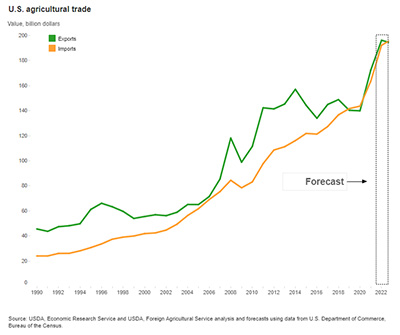


























The Information Age began in the later half of the 20th century, the dawning of the computer age. During the 21st century great technological and scientific advancement including the widespread use of computers, the internet, satellite communications, and mobile phones increased the rate of data or information transfer. At the same time, and with the use of these computational and communication tools, scientific and technological advancements led to bioengineering, robotics, sensors, and other tools that allowed farm products to be produced and processed with less labor and with greater efficiency. The cloning of the first piglets, the sequencing of plant genomes, and new genetically modified foods are just a few of the scientific advancements that took place during this era.
Several policies and laws were also introduced in the United States that impacted the agricultural industry. Policies on nutrition, trade, and farm aid were part of the changes that took place during this era spanning three presidential administrations including Presidents George W. Bush, Barrack H. Obama, Donald J. Trump, and Joseph Biden. These policies and laws impacted local, state, national, and international agricultural production, consumption, and trade.
How will the scientific and technological advancements of this era impact the agricultural industry into the future? What roles should scientific and technological advancements play in agricultural production? What role(s) should the government play in the agricultural industry? How will policy impact international trade in both positive and negative ways? Consider these and other questions as you explore, “Growing A Nation: The Information Age.”


In the year 2000, the food and agriculture sector contributed $1.3 trillion - or thirteen percent - to the American Gross Domestic Product, and employed nine percent of the labor force.
In 2001 President George W. Bush appointed Ann M. Veneman to serve as the Secretary of Agriculture, the first woman to hold this very important position.
Today, significant changes are happening for every aspect of American society. Advances in science and technology are fueling a global economy. The pace of scientific research is accelerating. International trade, with ninety-six percent of the world's population living outside of our nation's borders, is expanding.
These changes bring American farmers fresh and complex challenges. New foreign pests and diseases emerge each year to threaten agricultural production. Terrorists exist who pose a threat to the nation's food supply. Food safety, nutrition and obesity are becoming increasingly serious health concerns for customers.
To address these challenges agricultural scientists and American farmers need to continue using the latest tools and technologies and to work closely together to keep agriculture competitive and to ensure that all Americans have access to a wide variety of safe, healthy and plentiful food. More young Americans also need to seek careers in the food industry and the agricultural sciences to meet the future needs of our nation.
American agriculture has greatly changed since its beginnings over two centuries ago but it is still the foundation of America's continuing experiment with democracy and a good life for our nation's citizens - a life of possibilites.
In the year 2000 the food and agriculture sector contributed $1.3 trillion – or thirteen percent - to the American Gross Domestic Product, and employed seventeen percent of the labor force. In 2001 President George W. Bush appointed Ann M. Veneman to serve as the Secretary of Agriculture, the first woman to hold this important position.


President George W. Bush
George W. Bush was sworn into office in January of 2001. President Bush led the American people through the difficult days following the September 11 attacks. Visit the White House website to read a brief biography of President Bush and answer the following questions.
President George W. Bush website
Questions
Which areas of President Bush's private life helped him become successful as President?
What has President Bush done that impacted your life the most?

Ann M. Veneman
"Ann M. Veneman was sworn in as the 27th Secretary of the U.S. Department of Agriculture (USDA) on January 20, 2001. Her lifelong commitment to food and farm issues, along with her bipartisan approach to solving problems and confronting new challenges, are reasons that explain why she was chosen by President George W. Bush to serve in his Cabinet and unanimously confirmed by the U.S. Senate.
"Growing up on a family farm in a small rural community, Ann Veneman understands well the issues important to America's farmers and ranchers. She has spent much of her career dedicated to food and agriculture issues and advancing sound U.S. farm and food policies.
"President Bush has often said that the spirit of the American farmer is emblematic of the spirit of America, signifying the values of hard work, faith and entrepreneurship. Secretary Veneman believes strongly in these principles and since taking office, has worked to foster economic opportunities for farmers and ranchers, ensure a safe and wholesome food supply, protect agriculture against pests and diseases, encourage conservation and environmental stewardship, invest in rural communities, and support the next generation of agricultural leaders through new educational opportunities.
"Secretary Veneman [played] a key role in eliminating trade barriers and expanding opportunities for American farmers through new export markets. She [worked] closely with U.S. Trade Representative Robert Zoellick, helping lead to the successful launch of a new round of trade negotiations for the World Trade Organization.
"Following a devastating outbreak of foot and mouth disease in parts of Europe and the tragic events of September 11th, Secretary Veneman and her team acted swiftly to respond to potential threats and continues working to strengthen USDA's protection systems. The Secretary has been an advocate for strong pest and disease, food safety and research programs to ensure U.S. agriculture and consumers have a safe, wholesome food supply and the infrastructure to protect it.
"Secretary Veneman [was] a strong advocate of agriculture education and established the 'Leaders of Tomorrow' initiative to strengthen USDA education programs, particularly those involved with mentoring young adults.
"The Secretary earned her bachelor's degree in political science from the University of California, Davis, a master's degree in public policy from the University of California, Berkeley, and a juris doctorate degree from the University of California, Hastings College of Law. In a personal capacity, she serves as a board member of the Close Up Foundation, a nonpartisan civic education organization."
Questions
Swearing in Ceremony
What formal and informal training prepared Secretary Veneman for a position in President Bush's cabinet?
What would you focus on if you were the Secretary of Agriculture?

Free Trade in a Global Economy
"President George W. Bush said 'We know that nations that open their economies to the benefit of trade are more successful in climbing out of poverty...We also know that free trade encourages the habits of liberty that sustain freedom. . . .'
"The World Trade Organization (WTO) is the only global international organization dealing with the rules of trade between nations. The WTO agreements are negotiated and signed by the bulk of the world's trading nations and ratified in their parliaments. The goal is to help producers of goods and services, exporters, and importers conduct their business."
Questions
Do you think a global economy can work?
What problems do you see for the United States and other countries around the world?
What advantages are there to a global marketplace?
E. Kwan Choi, "The Foundations of the World Trading System," Economics 355, Iowa State University [online].
Near the end of the Clinton Administration several important legislative actions were taken to address emerging food concerns and solidify the role of agriculture regarding energy production.

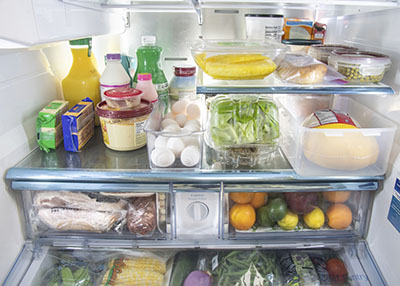
Global Food Safety Initiative - GFSI
In the 1990s, the food industry experienced some major crisis in outbreaks of listeria (bacterium), mad cow disease (BSE), and dioxins (highly toxic pollutants). Without a consistent method of ensuring food safety on a global scale, The Consumer Goods Forum (GCF), an international trade group, decided to take action, which led to the creation of the Global Food Safety Initiative in May 2000. GFSI is a non-profit organization whose goal is "once certified, always recognized".
Questions
Is a global food safety network essential? Why or why not?
How have global food safety issues changed over time?
What might be some challenges faced by the GFSI in working with developing countries?

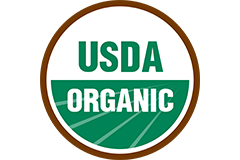
National Organic Standards
Congress passed the Organic Foods Production Act in 1990, however it took over a decade of working with all stakeholders for the U.S. Department of Agriculture (USDA) published the national organic standards (October, 2002) regarding the production and processing of organic foods.
Although not an indication of nutritional value or food safety, the organic certification seal is a marketing tool that provides information to consumers that certain requirements have been met in the production of the food source.
Foods that are organically certified are grown and processed according to specific federal guidelines, which include quality of the soil, insect and weed control, animal raising practices, and additive use. Produce that is labeled organic comes from soil that has had no use of forbidden synthetic fertilizers or pesticides for a period of three years before harvesting. With regard to meat, an organic label requires that the animal be raised in a natural-type habitat, be fed organic foods, and be free from antibiotic or hormone additives. In labeling packaged foods, artificial colors, flavors, and preservatives are generally prohibited.
Questions
In your opinion, is organic labeling important for consumers? Why or why not?

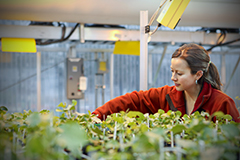
Biomass Research and Development
The Biomass Research and Development Act of 2000 provided government grants for the research and development of biofuels and biobased products from crops and feedstock (renewable, biological materials that can be used for fuel).
Biomass is organic plant and animal waste that can be used as a source of energy. Taking a relatively small amount of time to produce, rather than million of years for the formation of fossil fuels, biomass is a renewable energy source, the only renewable energy source that can be turned in liquid biofuels, such as ethanol and biodiesel fuel.
To learn more about biomass and its uses, use the National Geographic link below.
Questions
- Do you think biomass energy will help to solve our growing energy demands?
- The production and processing of food requires a lot of energy. What are other solutions to addressing U.S. energy needs?
Americans pay the least amount of their disposable income on food each year. Disposable income is the remaining income after taxes and mandatory expenses. Other nations around the world spend much more, some as much as 57% of their disposable income. On average, Americans spend 10% on food with over a quarter of a food dollar being spent on eating-out services.
https://www.ers.usda.gov/data-products/ag-and-food-statistics-charting-the-essentials/food-prices-and-spending

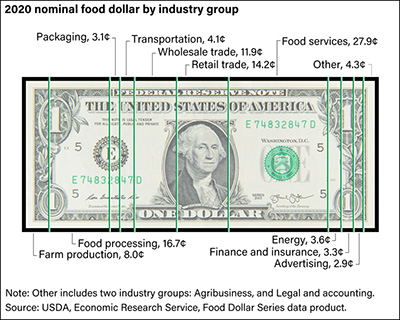
The American Food Budget
On average, Americans spend 10.3 percent of their disposable personal income on food—divided between food at home (5.2 percent) and food away from home (5.1 percent).
Questions
Using the graphs on the USDA Economic Research Service - Food Princes and Spending website, answer the following:
- Why do you think Americans, on average, spend less of their disposable income than people from other countries on food?
- Why do you think Americans spend 5.1% of their food budget on foods eaten outside the home?
- The 5.1% of disposable income spent outside of the home on food equates to about 28¢ of every food dollar spent going to a restaurant. Where does the other 92¢ go?
USDA - ERS

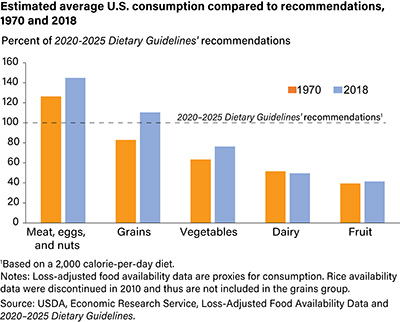
What's On America's Table?
While people in the United States are consuming more vegetables and fruit than in 1970, the average U.S. diet still falls short of the recommendations in the 2020–2025 Dietary Guidelines for Americans for these major food groups. On average, 2018 consumption of meat, eggs, and nuts as well as grains in the United States was higher than the recommended amounts.
Questions
Based on the information in the graph, what food groups to Americans need to eat less and more of?
https://www.ers.usda.gov/data-products/chart-gallery/gallery/chart-detail/?chartId=58334

Hungry Planet: What the World Eats
Peter Menzel, a California photographer, and writer Faith D'Aluisio traveled to 24 countries to interview and photograph families to discover what they ate, as well as the weekly cost of their food. Analyze the photos and the information provided in the link below. Pay special attention to the types of food eaten, the number of people in each family, and the weekly grocery bill.
Questions
What similarities did you notice about the nations in the photographs? Differences?
If you had to spend a greater percentage of your money on food, what other things would you have to stop buying? How would your life be different?
Why do grocery bills differ so widely around the globe?
How does geography affect what people eat?

In 2016, $135.5 billion worth of US agricultural products were exported to nations around the world. The majority of US imports were sent to China, Canada, Mexico, Japan, and the European Union (comprised of 28 countries), which accounted for 61% of all exports. Together, China and Canada account for 31% of all US agricultural exports. Approximately 25% of commodities by value were exported, and included: 148.5 million tons of corn, soybeans, and other grains; 3.6 million tons of poultry meats; and 3 million tons of fresh fruit.
Based on the trend in the graph, is it possible that the U.S. could become a net importer of food within the next decade? Visit the USDA Economic Research Service webiste to view what the U.S. exports and imports.
https://www.ers.usda.gov/topics/international-markets-u-s-trade/u-s-agricultural-trade/outlook-for-u-s-agricultural-trade/

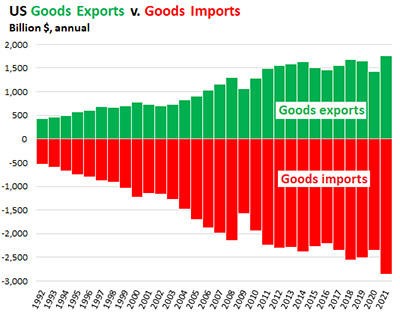
U.S. Trade: Exports v. Imports
While U.S. agricultural exports have historically exceeded imports and have positively contributed to U.S. trade the gap is narrowing. This impacts the U.S. balance of trade. A "trade deficit" occurs when a country imports more than it exports.
Questions
As you look at the graph of all U.S. Goods Exports v. Goods Imports, has their been a year when exports exceeded imports? In what year did the U.S. have a record level of exports?
https://www.wita.org/ustrade/us-trade-trends/the-us-trade-deficit/

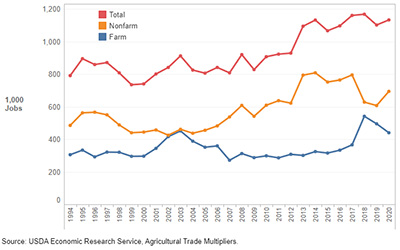
Agricultural Exports Provide Jobs
In 2020, Agricultural Exports Supported More Than 1 Million Full-time Civilian Jobs. U.S. agricultural exports support output, employment, income, and purchasing power in both the farm and nonfarm sectors. In 2020, every $1 billion of U.S. agricultural exports supported approximately 7,550 U.S. jobs throughout the economy. Agricultural exports in 2020 required 1,133,000 full-time civilian jobs, which included 694,000 jobs in the nonfarm sector.
Questions
What kind of careers whould be part of the "nonfarm" sector?
https://www.ers.usda.gov/topics/international-markets-u-s-trade/u-s-agricultural-trade/outlook-for-u-s-agricultural-trade/
In the 2000 the total U.S. population was 287,600,000 (287.6 million); farmers made up 1.5% of labor force that worked on 2,128,982 farms. The average acreage farmed was 441. One farmer supplied food and fiber for 139 people.
In the 2010 the U.S. population was 309,300,000 (309.3 million); farmers made up about 1% of labor force and the number for farms shrank to 2,109,303. The average acreage farmed was 434. One farmer supplies food and fiber for 155 people.
In 2020, the U.S. population was 331,449,281 (331.5 million), the world population was 6.1 billion. The farmer population was steady at 1%, while the number of farms shank 2,012,050. The average acres farmed increased to 444. In 2020 one U.S. farmer supplied food and fiber for 172 people.
How is it possible to reduce the number of farmers and at the same time increase production (yield)? The world population is predicted to reach nearly 9 billion by 2050. What can farmers and the U.S. agricultural industry (scientists, engineers, agribusiness people) do to meet the demands for food and fiber sustainably for a growing population?
https://www.ers.usda.gov/data-products/foreign-agricultural-trade-of-the-united-states-fatus/u-s-agricultural-trade-data-update/
An international consortium announced the first DNA sequencing of a plant genome, the flowering mustard Arabidopsis thaliana. Research indicated that plants may be much more complex organisms that were once believed.

Exploring the First 50 Sequenced Plant Genomes
While the first plant to have its genome sequenced was a member of the mustard family in the year 2000, the rate of decoding plant genomes has been rapidly increasing since then. From the following link, read more about genome sequencing and the first 50 plant genomes that have been sequenced.
Questions
What is genome sequencing?
Based on the website, what plant genomes have been sequenced?
Why do genomes vary so much in size?
Should plant genomes be sequenced? Why or why not?
Fisher, Madeline. "Exploring the first 50 sequenced plant genomes." Crop Science Society of America. 2018. Web. 16 August 2018.
Farmers' markets, a common area or facility where farmers and growers are able to sell fresh vegetables, fruits, and other commodities directly to consumers, began trending in the 1990s, but surged in 2000. These markets allowed small farmers to connect directly with the public and increase their profit margin or supplement their income, along with providing consumers the opportunity to purchase fresh high-quality produce, not always readily available in supermarkets.

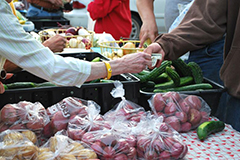
Farmer's Market
"Direct marketing of farm products through farmers markets continues to be an important sales outlet for agricultural producers nationwide. Farmers markets, now an integral part in the urban/farm linkage, have continued to rise in popularity, mostly due to the growing consumer interest in obtaining fresh products directly from the farm. The number of farmers markets in the United States has grown dramatically, increasing 79 percent from 1994 to 2002. According to the 2002 National Farmers Market Directory, there are over 3,100 farmers markets operating in the United States. This growth clearly indicates that farmers markets are meeting the needs of a growing number of farmers with small- to medium-size operations."
Questions
Why have farmers' markets grown in popularity among consumers?
Why have they become more popular for smaller farmers?
"Farmers Market Facts," Agricultural Marketing Service, U.S. Department of Agriculture [online].

Roots of Farmers' Markets
The history of farmers' markets dates back to 1730 in Lancaster, PA, when city planners designed Lancaster Central Market, a 120-square-foot plot in the middle of the city. Farmers' Markets were popular among people from all walks of life. For example, in July 1806, President Thomas Jefferson traveled to a local Georgetown market for fresh vegetables, beef, and eggs. He was used to fresh produce that came from his Monticello farm in Charlottesville, VA, so a farmers' market was valuable to him. He even documented vegetables that were sold in the Washington, DC area, a total of thirty-seven different varieties.
In the first decades of the 20th Century, local markets were commonplace. However, with the advancements in transportation, refrigeration, and improved roads, supermarkets were built, which soon replaced the popularity of farmers' markets. In the 1970s, a green revolution took root once again, particularly in New York City and California, which led to the concern of where food came from and how it was grown, along with a desire to protect farmland and improve conservation practices.
Questions
In the early to mid-1900s, why might people prefer to shop at supermarkets, rather than farmers' markets? Explain.
What is the value of having local farmers' markets, rather than a grocery-store only option of purchasing food?
Jablow, Valerie and Horne, Bill. "Farmers' Markets." Smithsonian Magazine. June 1999. Web. 31 July 2018. Neal, Arthur. "Meet Me at the Market." USDA. 7 Aug. 2013. Web. 31 July 2018.
Several events impacting trade occurred at the dawn of the 21st Century. Global economic conditions drive demand for food and agricultural products, providing the foundation for U.S. agricultural trade. Therefore, the composition and pattern of U.S. agricultural exports and imports shift to reflect changes in trade policies, world population and income, and economic growth. Other factors affecting U.S. agricultural trade include global supplies and prices, changes in exchange rates, and government support for agriculture. Learn more about how a few some of these events influenced the next two decades.

Y2K Scare
The Y2K scare was a phenomenon that had people in fear that on December 31, 1999, computers would shut down, which led to the spending of millions of dollars by government and private sectors to prevent the problem. Prior to the year 2000, computer programmers had used a two-digit code to represent the year, rather than the standard four-digits. People were concerned that once a computer hit the year "00", it would fail. Transport systems, particularly the airlines, were concerned that flight times would be inaccurate. Banking systems, which heavily rely on computer software, worried that the calculation of daily interest rates might fail. This caused a decline in stock prices for banks. Government institutions, hospitals, and other businesses were impacted, as well.
The solution was to create new software programs that included a four-digit code to represent each year, along with amending the algorithm that was used to calculate leap years.
View the National Geographic video clip on Y2K.
Questions
How did the Y2K scare affect the society? Were those fears justified?
If Y2K disrupted computer systems, how would have farms and food processing, transportation, and distribution been impacted?

Department of Homeland Security
In response to the terrorist attacks on September 11, 2001, the President created the Department of Homeland Security, to coordinate counter terrorism efforts. Biosecurity is an important part of the Bioterrorism Preparedness and Response Act of 2002. Visit the Homeland Security website pages on biosecurity efforts, and answer the following questions.
Homeland Security Biological Security
National Bio and Agro- Defense Facility
Plum Island Animal Disease Center
Questions
How do you feel about our government's actions to improve security?
What are some of the animal and plant programs that make our nation's agricultural system more secure?

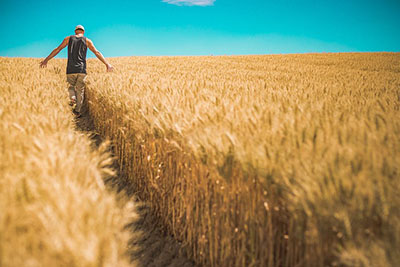
Agroterrorism
On September 11, 2001, terrorist hijackers flew airplanes into the World Trade Center's twin towers in New York City, NY, killing 2,606 people. The Pentagon was attacked, as well, leaving 125 Pentagon workers dead. Another plane destined for Washington, DC, was diverted by passengers who overpowered the hijackers, and crashed in a field in Shanksville, PA. A total of 2,996 people perished in the attacks, wounding an additional 6,000.
Questions
While these attacks did not spread to our food sector, people were concerned that "agroterroism" could disrupt and harm Americans.
Review this article "Agroterrorism: What Is the Threat and What Can Be Done About It?"
What areas of the food system do you think is most vulnerable? Why?

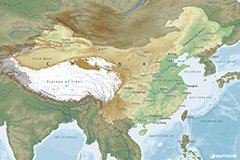
What is the WTO?
The World Trade Organization (WTO), created in 1995, is the only international organization that governs the rules of trade. It grew from the General Agreement on Tariffs and Trade (GATT), which began after WWII in 1948. The WTO is responsible for solving trade disputes between nations and help trade move as smoothly as possible. Principles of the WTO include lowering trade barriers, such as bans and tariffs, discouraging unfair practices, help developing nations transition to market economies, work to protecting the environment, and not discriminate between trading partners or various products.
On December 11, 2001, China became the 143rd member of the World Trade Organization (WTO) after lengthy negotiations that required vast changes to their economic structure, such as the elimination of various tariffs and opening agricultural trade. The WTO establishes rules for global trade and promotes effective practices for a market economy.
Use the WTO website to answer the following questions.
Questions
What is the purpose and value of the WTO?
How many nations are members of the WTO, and where is it located?
Why is the WTO relevant in our world today?
Why do you think China's membership in the WTO newsworthy?
The Farm Security and Rural Investment Act of 2002, signed by President George W. Bush, was passed to address water and other environmental issues. Programs included the Conservation Security Program, which created a reward system for eco-conscientious farmers, and it increases funding for conservation programs by 80% over 10 years.
Bioengineering is an umbrella term for a broad set of technologies, including things like genetic engineering, biochemical engineering, and bioprocess engineering. In the 1990s and early 2000s, scientists began to use the tools of biotechnology (biology tools) to genetically modify plants and animals to benefit farmers and consumers. Although there has been stringent governmental oversight by the USDA, the Food and Drug Administration (FDA), and Environmental Protection Agency (EPA), not all products have been accepted by farmers or consumers.
https://foodinsight.org/genetically-modified-organisms-and-our-food-supply/

The Safety of Bioengineered Foods
There has been an on-going debate around the world about the use of GMOs. However, while the safety of genetically modified food has been part of the debate, science-based organizations agree GMO are safe to eat.
Questions
While GMOs have been found to be safe to eat, what other issues are people concerned about?
Do you think GMO crops or CRISPR, another gene editing technology, will help to feed people? How might the environment be impacted?

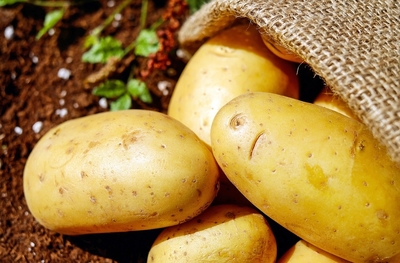
GMO Potatoes
Approved in 2014, the first GMO potatoes became available commercially for farmers to grow. These potatoes are non-browning, have reduced bruising and black spot, are blight resistant, and contain low acrylamide levels. Late blight continues to be a major problem for potato growers around the world, particularly in wet climates, and was responsible for the potato famine in Ireland in the mid-1840s.
Questions
How do GMO crops help farmers?
Are there consumer benefits? What concerns do you have about GMO crops?
What sources would you trust to learn more about the science of a GMO?

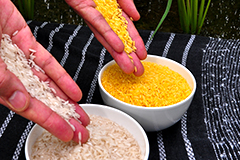
Golden Rice
Golden Rice, a genetically-modified rice containing beta-carotene, was introduced by Peter Beyer and Ingo Potrykus in an attempt to eradicate Vitamin D deficiencies in low-income nations. Vitamin A is essential for good vision and healthy immune systems.
Questions
Golden rice was originally rejected as a crop to help reduce blindness in locations where people had a vitamin A deficiency. Learn more about the pros and cons arguments about Golden Rice by reading this New York University Grossman School of Medicine article. After reading this article, do you think the benefits of planting and consuming golden rice outweigh the risks?
https://med.nyu.edu/departments-institutes/population-health/divisions-sections-centers/medical-ethics/education/high-school-bioethics-project/learning-scenarios/gmos-the-golden-rice-debate

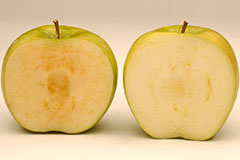
GMO Apples
The first GMO apple, named the "Arctic Apple" became commercially available in 2017. This non-browning apple produces no polyphenol oxidase (PPO), a plant enzyme that creates a chemical reaction that browns the fruit when cut, bruised, or bitten. A modified Golden Delicious apple, the Arctic Apple was genetically engineered by Okanagan Specialty Fruits, from British Columbia, Canada, through a process called RNA Interference, or gene slicing. By adding an extra strand of RNA, the gene is basically shut down, preventing the browning process.
To see current GMO crops that are currently available, use the link below.
Questions
How do GMO crops help farmers?
Are there consumer benefits? What concerns do you have about GMO crops?
What sources would you trust to learn more about the science of a GMO?
Gerlock, Grant. "Why The Arctic Apple Means You May Be Seeing More GMOs At The Store." NPR. 1 February 2017. Web. 27 July 2018.

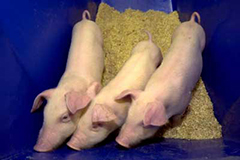
Cloning
On March 5, 2000, five female cloned pigs were born at the PPL Therapeutics laboratory in Blacksburg, Virginia. Scientists and colleagues from the Edinburgh-based company created the pigs using cloned adult cells, similar to the technique they used to create Dolly, the sheep. In the Food and Drug Consumer Magazine an article by Linda Bren wrote this,
"Proponents of livestock cloning see it benefiting consumers, producers, animals and the environment.
The consumer is looking for a nutritious and wholesome product provided to them in a repeatable and reliable manner and produced in a humane and ethical way,' says [rancher and veterinarian Donald] Coover, who also owns and manages SEK Genetics Inc., a beef cattle semen distribution company. 'If a consumer spends $30 on a steak dinner at a restaurant, they expect a great steak, but don't always get it.'
For farmers whose livelihoods depend on selling high-quality meat and dairy products, cloning can offer a tremendous advantage, says Coover. It gives them the ability to preserve and extend proven, superior genetics. They can select and propagate the best animals--beef cattle that are fast-growing, have lean but tender meat, and are disease-resistant[,] dairy cows and goats that give lots of milk and sheep that produce high-quality wool. Through cloning, it would be possible to predict the characteristics of each animal, rather than taking the chance that sexual reproduction and its gene reshuffling provide.
Coover compares the process of identifying a superior animal to spinning a giant roulette wheel. 'Sometimes you win, sometimes you lose, and sometimes you hit the jackpot.' But a producer cannot tell if he's hit the jackpot with a young animal. 'It's like trying to identify the school kid in the second grade who is going to grow up to solve the riddle of cancer,' says Coover. 'A rancher may think he has a good bull, but that bull has to sire calves, the calves have to mature and produce calves of their own, and this has to occur for several generations to know that it's not a fluke. By that time, the bull is dead and gone, and its genetics are lost to the industry.' Through SCNT cloning, even deceased animals can be cloned if a tissue sample is preserved in life or within a short time after death.
Cloning has the potential to improve the welfare of farm animals by eliminating pain and suffering from disease. 'From time to time, in nature, you find a naturally disease-resistant animal,' says [Larisa] Rudenko [a molecular biologist and risk assessor in the Food and Drug Administration's Center for Veterinary Medicine]. 'You can expand that genome through cloning, and then breed that resistance into the overall population and help eliminate major diseases in livestock.'
Cloning can reduce the number of unwanted animals, such as veal calves,' says Ray Page, chief scientific officer and biomedical engineer at Cyagra, a livestock cloning company. Veal calves are commonly surplus male offspring from dairy cows. Since the males don't produce milk, they are not as useful to the dairy industry and are turned into veal calves. Cloning can ensure the creation of more female offspring for dairy production.
An environmental benefit could result from cloning grass-fed instead of grain-fed animals. Grain-fed animals are known to be better tasting and more tender, but once in a while, a high-quality grass-fed animal comes along. 'If we can move our cattle-raising from a grain economy to a grass-fed economy, we can make food more efficiently and there are benefits to us as a society,' says John Matheson, a toxicologist and environmentalist who serves as a senior regulatory review scientist for biotechnology in CVM. Grass is a soil-building crop. In addition to reducing erosion, grass does not need the quantities of fertilizers and pesticides required by grain. And because forage is cheaper than grain, production savings can be passed on to consumers.
Cloning can help spread the best genetics over larger populations of animals,' says [Ph.D. Steven] Stice. When farm animals are cloned, genetic diversity may be reduced, but cloning can also be a tool to preserve rare genetics in livestock and, potentially, wild animals. Stice encourages zoos and wildlife refuges to preserve the tissue of endangered species in the hopes that technology in the theoretical stage today can be developed to regenerate these species in the future."
Questions
What are the anticipated benefits of cloning?
What are the anticipated drawbacks of cloning?
How might cloning impact our society?
Linda Bren, "Cloning: Revolution or Evolution in Animal Production?" FDA Consumer Magazine (May-June 2003) [online].
On June 30, 2004, President George W Bush signed the Child Nutrition and WIC Reauthorization Act, which amended the National School Lunch Act to encourage improved access to local foods in schools.

The WIC Program
The Women, Infants, and Children (WIC) Program was initially created as a pilot program in 1972 to provide food, education on nutrition, and access to health services for low-income women, infants, and children up to the age of five. The federal program became permanent in 1974 and is operated by the Food and Nutrition Service of the USDA, emphasizing its role as a nutrition program.
Congress allocates a specific amount funds each year for WIC, making it a grant, rather than entitlement, program. Based on 2015 statistics, WIC is operated through all 50 state health departments, 34 Native American Tribal Organizations, as well as Washington, DC, and 5 US territories (Puerto Rico, Guam, American Samoa, the Virgin Islands, and Northern Mariana).
In 1974, 88,000 people received WIC benefits. In 1980, 1.9 million; in 1985, 3.1 million; in 1990, 4.5 million; in 2000, 7.2 million; and by 2016, 7.7 milion. Children have always been the largest group to receve WIC benefits. In 2017, of the 7.3 million people who participated in the program, 3.76 million were children, 1.79 million were infants, and 1.74 million were women.
Questions
The WIC program provides for those in need. What suggestions do you have for reducing the increasing need for WIC benefits?
Food and Nutrition Services. "Women, Infants and Children (WIC)". USDA. 14 February 2018. Web. 12 July 2018.


Food and Nutrition
Eating healthy and maintaining a sense of well-being has been a major focus in the new millennium. In 2005, McDonald's announced that it would begin displaying nutrition facts on most of their fast-food menu items, including calories and fat content. By 2012, the company began displaying calorie counts on display boards in their restaurants. Other restaurants followed suit. This interest in diet and health led to the development of various strategic initiatives to improve proper health and nutrition.
Questions
Do you think having calories noted on restaurant menus makes a difference regarding personal food choice? Why or why not?
How would interests in food and nutrition change agriculture production and processing?
Food science is a multi-disciplinary field involving chemistry, biochemistry, nutrition, microbiology and engineering. Food scientists understand and develop new processing techniques and preservation methods. The increased reliance of society on ready-to-eat foods has led to greater responsibility for processors in terms of quality, safety and nutrition. In order to ensure high quality and competitive products, scientific principles and new technologies are being applied to food manufacturing and the body of knowledge required has become that discipline called Food Science.

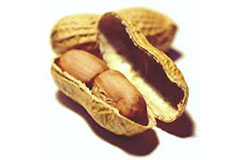
Nut Allergies
Researchers at the USDA discovered a peanut variety that lacks a major allergen, in hopes that a hypoallergenic peanut can be created. Peanut allergies, which can be fatal, affect over 1.5 million Americans. Researchers continue to determine what causes a food allergy, although genetic and environmental factors seem to be contributors. Statistically, one of 90 people in the US suffer from peanut allergies, between 0.6-1.0%, with an estimate of 20% of peanut allergies that can be outgrown. Peanut allergies are less common in Asia and Africa, where peanuts are staple foods.
Questions
What other food allergies have you heard of?
What are some other ways you think scientists can change foods to reduce allergens?
"Nut Allergy." The Peanut Institute.


Edible Coating for Sliced Apples
The Agricultural Research Service (ARS) developed an edible coating to keep sliced apples fresh, Patented in 1999 and made available nationwide in 2005, the sulfite-free coating consisted of vitamins and minerals, such as calcium and vitamin C, while preserving the fruit's color, texture, and flavor for up to 28 days.
Questions
- How might this innovation in food science appeal to consumers?
- How would this innovation impact restaurants, grocery stores, and the School Lunch Program?
The Energy Policy Act, signed by President George W. Bush increased biofuels research funding and provided incentives for the use of clean, renewable energy. General provisions included the authorization of clean coal initiatives, tax credits for producing alternative energy, loans for innovative technologies that avoided the use of greenhouse gases, and added ocean energy sources, such as wave and tidal power. The Congressional Budget Office estimated costs of the bill at $2.2 billion over the period of 2006-2010.
"Energy Policy Act of 2005." Wikimedia Foundation, Inc. 14 May 2018. Web. 27 July 2018.
Approximately one million honeybee colonies in the U.S. died during 2007, a total of 35.8%, due to several deadly viruses. These deaths resulted in entire bee colonies dying, this phenomena was named Colony Collapse Disorder.

Impacts of Colony Collapse Disorder
Honeybees are essential to agriculture. Crops such as apples, berries, and almonds, as well as three-fourths of all flowering plants, require pollination in order to be productive. It is estimated that one-third of our food comes from honeybee pollination.
Colony Collapse Disorder (CCD) was first reported during the winter of 2006-2007 when beekeepers began seeing high losses in their adult honeybee colonies. The bees would leave the hives, almost all at the same time. The queen was often discovered in the hives with the immature bees, and sufficient food supplies, but without many attending bees.
Major factors threatening honey bee health can be divided into four general areas: parasites and pests, pathogens, poor nutrition, and sublethal exposure to pesticides. In reality though, these factors tend to overlap and interact with one another, which complicates determining the exact cause of CCD. In addition, there are other issues that have impacts on honey bee health such as the narrow genetic base of honey bees in the United States.
Questions
How does the reduced number of honey bees impact what you might be able to purchase at the grocery store?
In 2008, the US faced the worst financial disaster since the Great Depression. Beginning with high-priced real estate taking a downward spiral in 2007, the crisis spread through the US financial sector and infiltrated the global economy. According to the Dow Jones Industrial Average, the US lost 33.8% of its value, and by the end of the year, the entire globe was entrenched in an economic recession.
Contributing to this crisis was the price of food. World food prices increased dramatically in 2007 and early 2008, creating a global crisis. Many nations experienced food riots and political instability, threatening governments and social unrest throughout Asia, Africa, the Middle East, Latin America, and the Caribbean. The rise in food staples, such as corn, rice, soybeans, and wheat was devastating to poor and developing nations worldwide.
In a study conducted by the International Food Policy Research Institute in 2010, major factors of the global food crisis of 2007-08 included: increased demand for biofuels, which drove up the price of corn and soybeans; higher oil prices; poor weather that decreased wheat production in Ukraine, Australia, and Argentina; bans on various exports and panic buying, especially for rice exports which experienced global price increases from $350 to $1,000; and the falling value of the US dollar.
When food prices increase, the poor are impacted the most, leaving them to spend the majority of their disposable income on staple grains, and less on fruits, vegetables, and non-food items, which has a significant impact on nutrition.
Consider these questions:
How does the concept of supply and demand apply to a global food network?
How does a global food crisis impact nutrition for the poor?
Havemann, Joel. "The Financial Crisis of 2008." Encyclopaedia Britannica, Inc. 2009. Web. 26 July 2018. "Factbox: 2008 food price crisis -- what caused it?" Reuters. 9 June 2011. Web. 31 July 2018.
The Food Conservation, and Energy Act of 2008 "farm bill" was passed by Congress on June 18, 2008 on an override of a presidential veto, the bill was an effort to continue government subsidies on agricultural production, research, and other issues. The first farm bill was passed in 1933. The "Agricultural Adjustment Act" was a response to the farming impacts of the Dust Bowl, and to aid consumers experiencing the crisis of The Great Depression. Since then, farm bills have been renewed about every 5 years. The farm bill typically is renewed about every five years. Farm bills typically address the following:
Commodities: The Commodities title covers price and income support for the farmers who raise widely-produced and traded non-perishable crops, like corn, soybeans, wheat, and rice – as well as dairy and sugar. The title also includes agricultural disaster assistance.
Conservation: The Conservation title covers programs that help farmers implement natural resource conservation efforts on working lands like pasture and cropland as well as land retirement and easement programs.
Trade: The Trade title covers food export subsidy programs and international food aid programs.
Nutrition: The Nutrition title covers the Supplemental Nutrition Assistance Program [SNAP] (formerly known as food stamps) as well as a variety of smaller nutrition programs to help low-income Americans afford food for their families.
Credit: The Credit title covers federal loan programs designed to help farmers access the financial credit (via direct loans as well as loan guarantees and other tools) they need to grow and sustain their farming operations.
Rural Development: The Rural Development title covers programs that help foster rural economic growth through rural business and community development (including farm businesses) as well as rural housing, and infrastructure.
Research, Extension, and Related Matters: The Research title covers farm and food research, education, and extension programs designed to support innovation, from federal labs and state university-affiliated research to vital training for the next generation of farmers and ranchers.
Forestry: The Forestry title covers forest-specific conservation programs that help farmers and rural communities to be stewards of forest resources.
Energy: The Energy title covers programs that encourage growing and processing crops for biofuel, help farmers, ranchers and business owners install renewable energy systems, and support research related to energy.
Horticulture: The Horticulture title covers farmers market and local food programs, funding for research and infrastructure for fruits, vegetables and other horticultural crops, and organic farming and certification programs.
Crop Insurance: The Crop Insurance title provides premium subsidies to farmers and subsidies to the private crop insurance companies who provide federal crop insurance to farmers to protect against losses in yield, crop revenue, or whole farm revenue. The title also provides USDA’s Risk Management Agency (RMA) with the authority to research, develop, and modify insurance policies.
Based on the content of farm bills, how are both producers and consumers impacted by a farm bill?
View this video overview of the farm bill.
"H.R. 2419 110th Congress: Food, Conservation, and Energy Act of 2008". www.GovTrack.us. 2007. Web. 26 July 2018. https://sustainableagriculture.net/our-work/campaigns/fbcampaign/what-is-the-farm-bill/
Growing food and moving it from farm to fork involves several steps and many hands. In a highly efficient, modern agricultural system (like we have in the United States), the following steps take place during food production: Preparation (getting ready to grow); Growing; Harvesting and transportation (moving food from the field); Storage; Processing; Distribution; Preparing and consuming the food (at home or in a restaurant)
Many of these food production steps require integrated systems including transportation and an ample supply of energy (fuel and electricity). Each step also involves a great number of people, including bankers, agricultural suppliers, farmers and farm workers, truck drivers, food handlers, government inspectors, millers, bakers, and chefs. Weather conditions, energy price and availability, storage facilities, and transportation problems can all affect this food system. Our highly efficient and productive agricultural system, (the United States produces a surplus of food), a breakdown in the system can usually be fixed or dealt with quickly. However, just because we have food does not mean all are fed. Hunger is a problem in the U.S. and in other countries. Geography (climate or weather conditions), infrastructure (for transportation, storage, food processing, and distribution), monetary system (many are poor), or political system to move food effectively from farms to forks may become broken, or in some cases nonexistent. These are some of the major reasons why hunger exists in the developed and developing world. The reasons for hunger in the United States center more on poverty. Some people don’t have enough money to purchase food.

Stats for a Hungry Planet
Population and productivity continued to grow in the new century. A few videos captured the trends, growing demand for food, and the productivity of farmers. These videos also highlight challenges ahead—populations increasing while farmland staying the same.
View the linked videos before answering the questions.
A World Without Farmers - One Hungry Planet (2010)
Growing Today For Tomorrow (2013)
Questions
Population and productivity continued to grow in the new century. A few videos capture the trends, growing demand for food, and the productivity of farmers. The linked videos highlight challenges ahead—populations increasing while farmland stays the same.
With some of the facts cited in the videos, what is solutions might you propose to feed the growing population?
What technologies do you think will help to solve some of the food challenges of a growing population?
Can American farmers feed the world? Should they?

Who is Hungry
The goal of the World Food Programme (WFP), founded in 1961, is to deliver food assistance to those in emergency situations and ensure that everyone in the world has access to good nutrition, not just food.
Explore the interactive World Hunger Map to learn about food availably.
Questions
Using the layers of the World Hunger Map, what patterns do you see? What are some possible solutions to end world hunger?

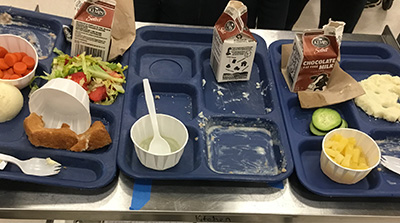
Food Waste
"In the United States, food waste is estimated at between 30-40 percent of the food supply. This estimate, based on estimates from USDA’s Economic Research Service of 31 percent food loss at the retail and consumer levels, corresponded to approximately 133 billion pounds and $161 billion worth of food in 2010. Reducing this loss and waste could generate a number of benefits to society:
- Wholesome food that is currently wasted could help feed families in need.
- Land, water, labor, energy and other inputs that are used in producing, processing, transporting, preparing, storing, and disposing of discarded food could be conserved to protect the environment.
- Greenhouse gases generated from food rotting in landfills could be reduced to help mitigate climate change.
Food loss occurs for many reasons, with some types of loss—such as spoilage—occurring at every stage of the production and supply chain. Between the farm gate and retail stages, food loss can arise from problems during drying, milling, transporting, or processing that expose food to damage by insects, rodents, birds, molds, and bacteria. At the retail level, equipment malfunction (such as faulty cold storage), over-ordering, and culling of blemished produce can result in food loss. Consumers also contribute to food loss when they buy or cook more than they need and choose to throw out the extras."
During this era there were many changes to USDA policies and programs regarding farming and nutrition. Many different government organizations and agencies got involved in initiatives promoting sustainable practices in gardening, getting to know the farmers producing America’s food, and changes to everyday nutrition.


Know Your Farmer, Know Your Food
In February 2009, Tom Vilsack, Secretary of Agriculture, launched The People's Garden initiative on the 200th birthday of Abraham Lincoln, who created the Department in 1862. He referred to it as "The People's Department." The purpose of The People's Garden was to help USDA employees create community gardens and encourage sustainable practices that benefit the environment. As of 2017, over 1,200 People's Gardens were in existence, providing educational resources and giving people the opportunity to grow their own food.
In the fall of 2009, Secretary Vilsack announced the "Know Your Farmer, Know Your Food" Initiative to help individuals understand where their food comes from and how it gets to their plates. Using existing programs to support the development of local and regional food systems, the initiative's goal was to provide new income opportunities for local growers, increase sustainable agricultural practices, decrease the energy used to transport foods, and keep heathy options available to local consumers.
To learn more about what this program's goals were, view this video "Know Your Farmer, Know Your Food."
Questions
What underlying factors may have contributed to the development of this program?

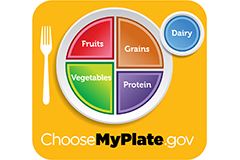
MyPlate
In 2011, First Lady Michelle Obama, along with Secretary of Agriculture Tom Vilsack, and Surgeon General Dr. Regina Benjamin, unveiled the new food guide for a healthy diet known as MyPlate. Replacing MyPyramid, the MyPlate provided a visual display of an individual's plate sectioned into four parts: grains, protein, fruits, and vegetables, with half of the plate being fruits and veggetables. A separate circle represents dairy products.
To read Michelle Obama's remarks on the MyPlate announcement, go to the following website: Remarks by the First Lady at MyPlate Icon Announcement.
To learn more about the MyPlate initiative visit: MyPlate.gov
Questions
- What underlying factors may have contributed to the revision of MyPyramid to MyPlate?
- Does MyPlate help you to visualize recommendations for your eating?
President Barrack H. Obama was sworn into office as president of the United States on January 20, 2009. He served two terms ending on January 20, 2017 and was the United States’ 44th president. Legislation passed during President Obama’s time in office included several bills to impact agriculture in the United States.


2009 American Recovery and Investment Act
Signed by President Barack Obama, the American Recovery and Reinvestment Act of 2009, also known as the "Recovery Act" or "The Stimulus", was a $787 billion economic stimulus package to help end the Recession of 2008. The main objective of the Act was to create emergency relief by saving and creating jobs. In addition, the package was to invest in infrastructure, education, health services, renewable energy, expansion of unemployment benefits, and federal tax incentives.
Questions
Why was it important during this time period for this stimulus package to be passed?
What events were going on during this time period to lead to the policies within this law?
Congressional Research Service. "H.R. 1 (111th): American Recovery and Reinvestment Act of 2009". www.govtrack.us. 2009. Web. 26 July 2018.

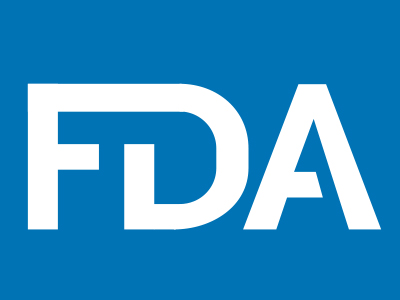
2011 FDA Food Safety Modernization Act
The Food Safety Modernization Act (FSMA) was signed into law by President Barack Obama on January 4, 2011. The FSMA provided the Food and Drug Administration (FDA) new authorities to regulate the way food is produced (grown/harvested) and processed. The law granted the FDA the power to conduct mandatory recalls and issue guidance documents to reduce incidents of foodborne illnesses. This bill was considered the first major piece of federal legislation addressing food safety since 1938.
Questions
How do consumers benefit from the FSMA?
Why are the regulations included in the FSMA important for the production and consumption of agricultural products in the United States?
FDA.gov


2012 Federal Public Transportation Act
The Federal Public Transportation Act of 2012 (also called the Moving Ahead for Progress in the 21st Century Act) was passed and provided funding for increased ridership of buses, subways, commuter trains, and ferry boats. In addition, the Act focused on improved safety and established a State of Good Repair program to help public transportation systems address growing maintenance needs.
Questions
What benefits are included in this transportation law?
How might this act impact climate change?

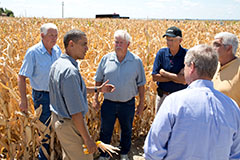
2012 Agriculture Reform, Food and Jobs Act
The Agriculture Reform, Food and Jobs Act of 2012 (S. 3240) represented the most significant reforms in agricultural policy in decades. The bill ended direct payments, streamlined and consolidates programs, and reduced the deficit by $23 billion. It also strengthened top priorities that continue to help farmers, ranchers, and small business owners grow our economy.
Questions
How did the 2012 Farm Bill impact the nation's economy?
What are the benefits and/or the challenges with the changes that were made in the 2012 Farm Bill?

The Agricultural Act of 2014
The Agricultural Act of 2014 (farm bill) was signed into law by President Obama on February 7, 2014 and remained in effect until 2018, with some policies extending beyond that timeframe. According to the USDA, “The 2014 Farm Act made major changes in commodity programs, adds new crop insurance options, streamlines conservation programs, modifies some provisions of the Supplemental Nutrition Assistance Program (SNAP), and expands programs for specialty crops, organic farmers, bioenergy, rural development, and beginning farmers and ranchers.”
Questions
Why do you think that the U.S. government creates a new farm bill every five years?
What do you think is the most important part of this farm bill in relationship to agriculture in the U.S.?
United States Department of Agriculture (USDA). (2018). Agricultural Act of 2014: Highlights and implications.
Technological advancements reach all the way back to the use of a stick to plant a see. Other mechanical inventions of note include Jethro Tull’s seed drill in 1701, John Deere’s steel plow in 1837, and the first gasoline tractor built by John Froelich in 1892. Technological advancements have also played a key role in agriculture during the Information Age. These digital advancements have changed the ways that farmers go about their daily work from planting to harvesting and beyond.
In the 21st Century satellite imagery, sensors, global positioning systems (GPS), global information systems (GIS), robotics, and weather and market databases resulted in the development and widespread use of precision farming techniques.
How might the introduction of these new technologies change the rotines of farmers? What additional technologies are needed to address farming risks and labor shortages?
In 1953, the USDA established the Agricultural Research Service (ARS) to focus its research efforts on a national scale. The accomplishments of ARS can be found on ARS's historical timeline. Their scientific innovations have impacted food production, processing, and safety.

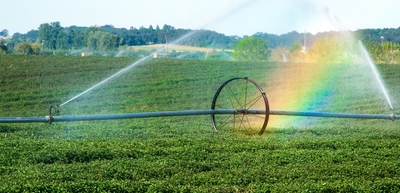
Irrigation
In 2005, Agricultural Research Service (ARS) began demonstrating how strategic use of irrigation water can reduce water use and boost its quality. In the seventeen neighboring states in the West, approximately 75% of the value of various crops are grown on 25% of irrigated land. Remote sensors, more efficient sprinklers, automation, and improved delivery systems (e.g., drip) allow farmers to produce greater yields and adapt to the effects of climate change. For example, in California, almond growers have discovered that the drip method has reduced the amount of water needed to grow a pound of almonds by 33%, based on their experiences. Water-saving measures and strategies are now being used on millions of acres across the American West, where irrigation can consume up to 90 percent of available water resources.
Questions
Use this ATS Irrigation website to learn more about modern irrigation systems.
Why do farmers need to be concerned with water use?
Is it possible to use one method of irrigation, like drip, on all types of crops? Why or Why not?

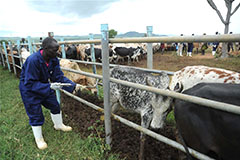
Foot and Mouth Disease
Foot-and-Mouth Disease is a highly contagious disease that occurs in wild and domestic animals, particularly those with cloven hooves. There are seven distinct types of the virus, with over sixty subtypes. The disease causes lesions, fluid-filled blisters, between the toes, heels, lips, tongue, and roof of the mouth. Lesions on the hooves, or feet, can prevent animals from walking, and those in the mouth can keep animals from eating or drinking.
Researchers at the Plum Island Animal Disease Center in Orient Point, NY, developed a safer vaccine to help combat Foot-and-Mouth Disease (FMD) in animals. Elizabeth Rieder, a microbiologist, and her colleagues used a DNA sequence that altered the FMD virus so they could study how it grows and interacts with host animals. Instead of using a virulent virus, the research team discovered how to create a weakened virus that does not cause disease, which is much safer than the traditional vaccine methods. The new vaccine may also be distinguished from other viruses that cause outbreaks.
There is often much confusion about Foot and Mouth Disease (FMD), also known as Hoof-and-Mouth Disease, and Hand, Foot, and Mouth Disease (HFMD). FMD affects animals, such as pigs, cattle, and sheep, and Hand, Foot, and Mouth Disease affects humans. The diseases are not related, and they come from different viruses.
Questions
What are possible outcomes or consequences of a foot-and-mouth disease outbreak?

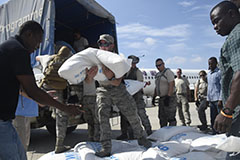
Emergency Food Development
Food technologist, Charles Onwulata, developed an instant, fully cooked, nutritionally fortified, corn-soy blend emergency aid food with a one-year shelf life. Onwulata developed the new food using the same process used in creating Cheese Puffs, or any other puffed cereal or snack. The "puffs" are then crushed and processed to create a powder, which can be reconstituted with clean water and turned into a porridge.
Twenty metric tons of this new food aid were able to be shipped to Haiti in 2011. after a 7.0 magnitude earthquake struck Haiti in 2010, devastating the island, affecting three million people, and leaving 1.6 million displaced and homeless. This effort has fed over 3,000 malnourished children and provided jobs for 128 disabled employees in the United States.
Bliss, Rosalie Marion. "Fully Cooked Emergency Aid Food." AgResearch Magazine. USDA. 2011. Web. 26 July 2018.

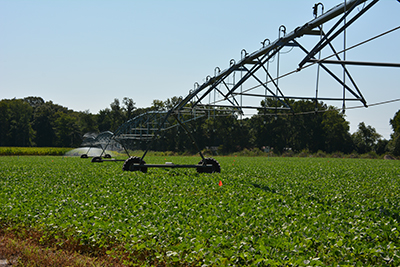
Automating Irrigation
Water is a key resource that plays an important role in agriculture across the United States. In states and regions where there is little rainfall it is key that the use of water is managed to provide the crops what they need to thrive. In areas like California where rain falls variably from year to year solutions must be put in place to ensure crops flourish.
According to the Agricultural Research Services (ARS), “ARS scientists have saved millions of gallons of water on farms in California and in other dry States by developing an automated irrigation scheduling system that targets water to where and when it is needed most. The technology monitors soil and crop conditions and records rainfall levels so that it can time irrigation with a sophisticated variable-rate center-pivot irrigation system. The technology is the first of its kind for center-pivot irrigation systems, which are used on more than 50 percent of the Nation’s irrigated croplands.”
Questions
What role does conserving water play in both sustainability and global climate change?
Agricultural Research Services. (2018). Saving watera precious global resource. Scientific Discoveries: The Impact of Agricultural Research Services (ARS) Research-Fiscal Year 2017, p. 13.

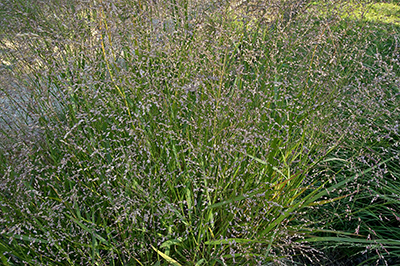
Renewable Fuels
Renewable fuels are assisting many rural communities economically. Looking to the field of biofuels, Agricultural Research Services (ARS) in Lincoln, NE developed a new perennial switchgrass called ‘Liberty’ that thrives in the Upper Midwest and provides 530 gallons of bioethanol per acre as compared to 567 gallons per-acre from corn grain that has to be grown on higher quality food-cropping land. According to the ARS, “This new ARS-developed switchgrass can grow on marginal lands where other crops can’t necessarily grow. It is also high yielding, meaning that it will generate more revenue for both farmers and the bio-refineries they supply. Hundreds of thousands of gallons of fuels are already derived each year from switchgrass, and the new variety should enhance the crop’s economic value.”
Questions
What are the economic and environmental benefits to the new Liberty switchgrass?
How does this new crop play a role in sustainability?
Agricultural Research Services. (2018). Making the unusable profitable. Scientific Discoveries: The Impact of Agricultural Research Services (ARS) Research-Fiscal Year 2017, p. 15.
Technology in all of its forms has played a key role in agriculture for centuries. Recall the list of technologies from the “Seeds of Change” including the flail, sickle, cast-iron plow, and the cotton gin. Technology continues to play a huge role agricultural production, processing, and food storage.

Precision Agriculture
Precision agriculture is a method of farming that uses technological innovations – including GPS guidance, drones, sensors, soil sampling and precision machinery – in order to grow crops more efficiently. Ultimately, precision agriculture techniques help farmers make more informed decisions through the use of artificial intelligence and data supplied by sensors in the ground, weather stations on the ground, along with infrared images taken by satellites and drones.
This video provides an overview about how farmers are using precision agriculture techniques.
Questions
At its core, precision agriculture is designed to improve the efficiency of production on farms.
What are the advantages of using precision agricultural production methods?
Do you foresee any negative or unintended consequences regarding precision agriculture methods?

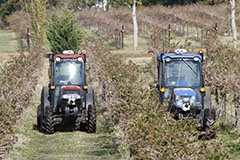
2012 First Self-Driving Tractor
Created by Terry Anderson, founder of the Autonomous Tractor Corporation, the first self-driving, autonomous tractor was unveiled at the Big Iron Farm Show in West Fargo, North Dakota. Anderson came out of retirement to design an automated tractor after hearing complaints from farmers about labor issues, increased tractor prices, and design problems. The 25,000-pound tractor, named The Spirit, is able to travel in a straight line, turn corners, prepare the soil for planting, destroy weeds, and cut hay.
Questions
How might the invention of the self-driving tractor impact the following elements of the agricultural industry--
- Daily life of farmers,
- Production/consumption,
- Supply/demand, and
- Work force?

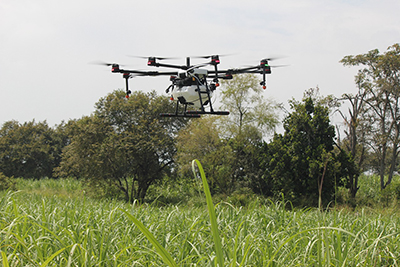
Using Drones in Agriculture
Unmanned aerial vehicles (UAVs), better known as drones, are not a new technology, but they are playing a bigger role in agriculture than in the past due to less regulation and more investments in the technology. There are two major reasons why drones will lend themselves to agriculture.
The first is the growing population which is projected to be at 9 billion people by 2050, this means that agricultural consumption could increase nearly 70% within this same time frame. The second challenge that could be remedied by the use of drones is extreme weather events which create obstacles to productivity. Great strides in the integration of drones into agriculture could be made with the collaboration of stakeholders including governments, technology leaders, and industry.
The MIT Technology Review lists six uses for agricultural drones including:
- Soil and field analysis
- Planting
- Crop spraying
- Crop monitoring
- Irrigation
- Health assessment
Looking to the future, drones may be sent out in fleets or swarms in order to monitor tasks collectively and/or hybrid aerial-ground drones could collect data and perform other tasks. Several issues continue to impact the progress surrounding the use of drones, as well as, integration into all industries. Some of these on-going issues include safety of drone operations, privacy issues, and insurance-coverage questions. One of the biggest issues when looking to the use of drones in agriculture is the type and quality of data received from the technology. In order to address this, the industry is pushing for more sensors and cameras. Other considerations in the integration of drones into agriculture include using drones that require minimal training and highly automated technology.
Questions
Progress in the area of drones has been impacted by less regulation and more industry investment in the technology. Why might the regulations surrounding the use of drones in agriculture make such a big impact in their use in the field of agriculture?
What role does industry “buy-in” and adoption play in the technological advancement of drones for use in the field of agriculture?
Looking at the list of six ways that drones could be used in the field of agriculture, how do you see this technology impacting each item on this list?
Now that you have considered how the technology might be utilized, dig deeper into the list by visiting--Six Ways Drones Are Revolutionizing Agriculture and read more about the drones’ impact on agriculture. How does this list compare with the ideas that you generated?
Can you think of additional uses for drones in the agricultural industry that have not been considered in the list?
Why might the uses of drones be advantageous for the agricultural industry?
Mazur, M. (2016). Six ways drones are revolutionizing agriculture. MIT Technology Review.

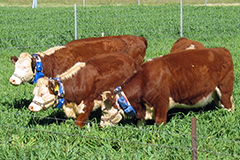
Wearable Technology for Livestock
In 2002, Agricultural Research Service rangeland scientist David Ganskopp from Burns, Oregon, installed GPS collars on twelve cattle to track movements and better understand why they tend to graze in certain areas. Using satellite coordinates from over two dozen satellites, data was entered into a computer, which used Geographic Information Systems (GIS) to determine specific environments of the grazing cattle.
With continued advances in technology, farmers and ranchers are able to use accelerometers, devices which measure acceleration, on grazing animals. In addition, GPS collars have become easier to manufacture at lower costs, which makes monitoring extensive rangeland more effective. Ranchers now have the ability to more quickly rescue animals in need.
Not only are high-tech collars now available for tracking livestock, there are many other options provided to farmers. The idea is that "precision farming," should be more efficient, as well as save time and money. Based on 2016 figures, livestock tracking devices were a $1 billion industry, with estimates of increasing to $2.5 billion by the year 2025.
Questions
Using the Modern Farmer website, what device would you buy to track and monitor your livestock if you were a rancher?
Elstein, David. "Tracking Movement of Cattle With Satellites." Agricultural Research Service. USDA. 12 August 2002. Web. 26 July 2018.
With the goal of sustainably feeding 9 billion people by the year 2050, the question must be posed, what steps are we taking today to meet this goal? Several other questions include-
- What does it mean to live sustainably in the 21st century?
- What roles and responsibilities do farmers have in this sustainability goal?
- What current practices in food production can remain the same and what needs to change?
- What is the United States’ role in sustainably feeding 10 billion people by the year 2050?
During Obama’s presidency he put forth initiatives to assist rural Americans and support the strengthening of rural communities. In addition, he also sought to advance and boost support for biofuel production and consumption in America.


2010 Energy Security Plan
President Barack Obama announced initiatives to boost advanced biofuel production, which included five research centers, the installation of 10k fuel pumps with access to ethanol fuel blends, the increase of biofuel use in USDA's fleet, and the resumption of USDA's Biomass Crop Assistance program.
Questions
What are the different ways that boosting the production and consumption of biofuels in the United States might impact agricultural planting, consumption, and distribution across America?
Vilsack, Tom."Boosting Advanced Biofuel Production and Creating Jobs." USDA. 2010. Web. 26 July 2018.

2011 White House Rural Council
By Executive Order, President Barack Obama announced the creation of a White House Rural Council to help rural communities meet economic challenges. President Obama said, "Strong rural communities are key to a stronger America." Chaired by Secretary of Agriculture Tom Vilsack, the Council coordinated programs across government to help strengthen rural communities. Specific goals included: the increase of broadband across America, improved access to quality healthcare, expansion of agricultural markets, the increased production of biofuels, and the improvement of job opportunities and training for people in rural areas.
Questions
Looking at the improvements that the White House Rural Council wanted to make to rural America, how might these changes impact the daily lives of rural Americans?
Office of the Press Secretary. "Obama Administration Establishes White House Rural Council to Strengthen Rural Communities." The White House. 9 June 2011. Web. 26 July 2018.
Many decisions are made when producing and consuming food in the United States. In addition to the decisions that producers make to produce food, fiber, and the raw products for manufacturing, consumers also have several decisions to make that include what types of food to buy, prices, and when to consume or throw food away. These are all things that you will be challenged to think about as you explore Sustainable Practices in Agriculture.

The Sustainable Development Goals
The United Nations’ focus with the Sustainable Development Goals includes poverty, inequality, climate, environmental degradation, prosperity, and peace and justice. Using the Sustainable Development Goals website explore the 17 goals and learn more about what this plan entails.
Sustainability Development Goals
Questions
Take a closer look at the 17 items within the Sustainability Development Goals. What goals may be the most challenging to achieve by 2030? Why might these specific goals be so challenging? What goals might be the easiest to achieve? Why might these goals be so easily achievable?
What are some of the programs and policies that the U.N. hopes to create with this plan? What role might the United States play in these policies and plans?
Looking at the goals, is there anything missing that you might add related to agricultural production, consumption, and trade? What might those items be and why do you think that they are important to add to the Sustainable Development Goals for 2030?
United Nations. (n.d.). Sustainable Development Goals. Retrieved from https://www.un.org/sustainabledevelopment/sustainable-development-goals/

What is Sustainable Agriculture?
According to the Agricultural Sustainability Institute, “The goal of sustainable agriculture is to meet society’s food and textile needs in the present without compromising the ability of future generations to meet their own needs. Practitioners of sustainable agriculture seek to integrate three main objectives into their work: a healthy environment, economic profitability, and social and economic equity. Every person involved in the food system—growers, food processors, distributors, retailers, consumers, and waste managers—can play a role in ensuring a sustainable agricultural system.”
Questions
Sustainable agricultural practices include:
- Promoting soil health
- Minimize water use
- Lowering pollution levels on the farm
What do you think are the biggest challenges to increasing sustainability in agriculture?
What is sustainable agriculture. (n.d.). Agricultural Sustainability Institute.


2030 Agenda on Sustainable Development
The United Nations’ focus with the Sustainable Development Goals includes goals to address poverty, inequality, climate, environmental degradation, prosperity, and peace and justice.
Using the Sustainable Development Goals website explore the 17 goals and learn more about what this plan entails.
Questions
What goals may be the most challenging to achieve by 2030? Why?
What goals might be the easiest to achieve? Why?
Looking at the goals, is there anything missing that you might add related to agricultural production, consumption, and trade?
United Nations. (n.d.). Sustainable Development Goals.

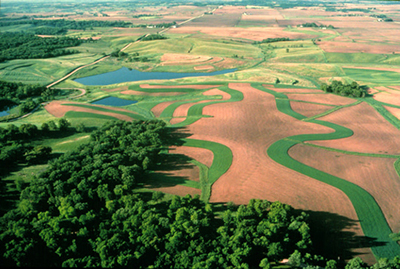
Conservation and Protecting Natural Resources
Provisions in the farm bill provide funding to farmers and ranchers for conservation efforts preventing soil erosion, preserving and restoring wetlands, cleaning the air and water, and enhancing wildlife. In addition to soil and water conservation, the practice of crop rotation also plays a role in caring for the land, as well as, contour farming where farmers plant crops across slopes for purposes of water conservation and protecting the soil.
According to the American Farm Bureau, “No-till or conservation tillage—a way of farming that reduces erosion (soil loss) while using less energy—is used on more than twice as many cropland acres compared to conventional tillage. Advanced conservation practices are used on more the 50 percent of cropland.
Questions
Looking at the practices that farmers and ranchers use to protect natural resources and support conservation, can you think of other practices that could be integrated into farming and ranching to protect water, soil, and wildlife?
American Farm Bureau Foundation for Agriculture. (2017). Environment. Food and Farm Facts, pp. 20-21.

Food that Never Leaves the Farm
It is calculated that U.S. food waste equates to 40% of food not including on-farm food loss. Some estimate on-farm food loss at 30%. When researchers look at the food that never leaves the farm there is a story to be told. Fruits and vegetables that are planted and never harvested or harvested but not sold because they have imperfections, often times caused by weather, have an environmental, economic, and social impact.
There are a few markets for farmers to consider when deciding whether or not to harvest the “ugly produce.” These markets include programs at grocery stores, subscription box home delivery programs, and food banks.
Questions
Farmers have many decisions to make when deciding if they will harvest “ugly produce.” Consider these questions:
What are the pros and cons of choosing to harvest “ugly produce” or leaving the “ugly produce” behind?
Who may be impacted by your decisions?
What are some ways you can think of to have more consumers eat "ugly produce?"
Dunning, R. D., Johnson, L. K., & Boys, K. A. (2019). Putting dollars to waste: Estimating the value of on-farm food lose. Choices, Quarter 1.
President Donald J. Trump was sworn into office on January 20, 2017 as the 45th president of the United States. Legislation and policies passed during President Trumps time in office included an updated farm bill and renegotiating several international trade deals.


The Agricultural Improvement Act of 2018
The Agricultural Improvement Act of 2018 was a bipartisan "farm bill" singed into law by President Trump on December 20, 2018. According to the Republican Policy Committee, “H.R. 2 amends and extends major programs for income support, food and nutrition, land conservation, trade promotion, rural development, research, forestry, horticulture, and other miscellaneous programs administered by the Department of Agriculture (USDA) for five years through 2023"
Questions
After exploring the summary of H.R. 2 (A Summary of H.R. 2), what do you think is the most important components of this new farm bill?
Who is most impacted by this law and in what ways?
Why do you think that the United States government makes it a priority to update the farm bill every five years?
Republican Policy Committee. (2019). H.R. 2(115th): Agriculture Improvement act of 2018.

2017-2019 Trade and Tariffs
In 2017, the United States traded $140 billion worth of goods with China the majority of those being agricultural goods including farm and ranch products. Exports to China in 2017 were $19.6 billion resulting in China being the second-largest export market for U.S. farmers and ranchers. In retaliation for tariffs imposed on aluminum and steel in September of 2018, China imposed large tariffs on 90% of U.S. agricultural exports. These retaliatory tariffs will result in China moving from the second-largest trading partner in 2017 to the fifth-largest trading partner in 2019.
In addition to China, other countries have imposed retaliatory tariffs on the United States including the European Union, Canada, and Mexico. Tariffs on Mexico, Canada, and China have resulted in a $12 billion USDA federal assistance program resembling Depression Era policy. This federal assistance gives farmers in need direct payment assistance. The government will buy goods from farmers including fruit, nuts, and rice to be distributed at food pantries. One major impact of the tariffs is that the USDA is forecasting a 12-year low in farmer income.
Questions
Who are the stakeholders that will be most impacted by the tariffs imposed on the U.S.’s international trading partners?
How will these stakeholders be impacted by the tariffs?
How will President Trumps policies and tariffs impact American agricultural trade in the short term?
How will these trade and tariff policies impact American agriculture in the long term?
American Farm Bureau Federation. (2018). Farm Bureau details trade, tariff impacts on agriculture. Honig, E. (Writer). (2018). Trump attempts to blunt tariff impact on U.S. farmers. [Morning Edition]. National Public Radio.

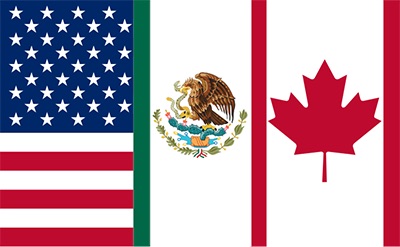
2018 United States-Mexico-Canada Agreement (USMCA)
In 2018, President Trump renegotiated and reconceptualized the North American Free Trade Agreement (NAFTA) that first took effect on January 1, 1994. This new agreement with Canada and Mexico is known as the United States-Mexico-Canada Agreement (USMCA). This new trade agreement will take effect in 2020 and will be reviewed by all parties every six years. To learn more about USMCA please watch Six Big Changes NAFTA’s replacement, the USMCA, makes.
For more information on USMCA please see the various fact sheets found through the Office of the United Staes Trade Representative--United States-Mexico-Canda Agreement
Questions
According to the video, how will the agricultural industry be impacted by USMCA? Are these changes positive or negative for the agricultural industry? In your response please explain why you think these changes are positive or negative.
What might the long-term and short-term effects of USMCA be on the production, consumption, and trade of agricultural goods in North America?
Elker, J. (Producer). (2018). Six Big Changes NAFTAs replacement, the USMCA, makes. [Video].
The disruptive impacts of the COVID-19 pandemic on the U.S. agricultural system were broad and varied. The crisis amplified problems in over-production, low prices, and, in some cases the availability of food. With more people eating at home, there were changes in demand of how product were packaged. With Americans eating 30-40% of their food out of the home, food products had been packaged in larger volumes for restaurants and schools.
"The magnitude and speed with which the COVID-19 outbreak affected the economy in general, and the food system in particular, motivated Congressional action in the CARES Act and dictated the scale and nature of USDA’s responses. It became quickly obvious that this crisis was nothing like we have ever experienced and that it could pose a real threat to the viability of many farming operations and, with it, to the sustainability of our domestic food supply."
https://www.usda.gov/media/blog/2020/09/24/americas-farmers-resilient-throughout-covid-pandemic#:~:text=Overall%2C%20agricultural%20exports%20during%20the,percent%20for%20non%2Dag%20exports.
According to NASA:
“The Earth's climate has changed throughout history. Just in the last 650,000 years there have been seven cycles of glacial advance and retreat, with the abrupt end of the last ice age about 7,000 years ago marking the beginning of the modern climate era — and of human civilization. Most of these climate changes are attributed to very small variations in Earth’s orbit that change the amount of solar energy our planet receives.
The current warming trend is of particular significance because most of it is extremely likely (greater than 95 percent probability) to be the result of human activity since the mid-20th century and proceeding at a rate that is unprecedented over decades to millennia.1
Earth-orbiting satellites and other technological advances have enabled scientists to see the big picture, collecting many different types of information about our planet and its climate on a global scale. This body of data, collected over many years, reveals the signals of a changing climate.
The heat-trapping nature of carbon dioxide and other gases was demonstrated in the mid-19th century.2 Their ability to affect the transfer of infrared energy through the atmosphere is the scientific basis of many instruments flown by NASA. There is no question that increased levels of greenhouse gases must cause the Earth to warm in response.
Ice cores drawn from Greenland, Antarctica, and tropical mountain glaciers show that the Earth’s climate responds to changes in greenhouse gas levels. Ancient evidence can also be found in tree rings, ocean sediments, coral reefs, and layers of sedimentary rocks. This ancient, or paleoclimate, evidence reveals that current warming is occurring roughly ten times faster than the average rate of ice-age-recovery warming.3”
Climate change: How do we know? (2019). NASA.

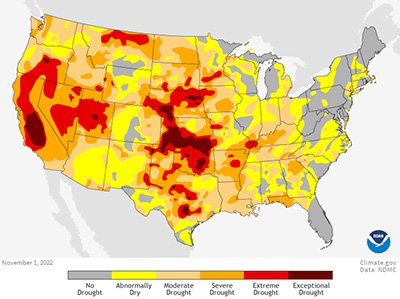
U.S. Drought Monitor
Extreme weather has been experienced in the early decades of the 21st Century. Farmers monitor weather throughout the growing season; planting, irrigation, and cultivation, for a productive harvest. The U.S. Drought Monitor website provides weekly updates to a map showing drought intensity and impacts.
Questions
View this three-minute Drought Monitor Time Lapse Map.
Then explore the U.S. Drought Monitor website. Experiment with the Comparison Slider map.
- Has your area experienced a drought in the last 10 years?
- What are the consequences of a prolonged drought
- Using the Data tab, how would farmers use this map to qualify for drought relief with the Farm Service Agency (FSA)?
https://droughtmonitor.unl.edu

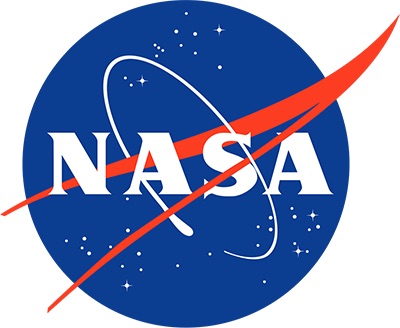
Questions About Climate Change
NASA has created a “Frequently Asked Question” (FAQs) page where people have submitted their questions and answers have been provided.
The NASA: Global Climate Change website answers additional questions about, the evidence, causes, effects, and solutions regarding climate change.
Questions
What have you learned about global climate change?
What questions do you have regarding global climate change?
How does climate change impact agriculture?
NASA: Global Climate Change. (2019). NASA. Retrieved from https://climate.nasa.gov

Climate Impacts on Agriculture and Food Supply
Agriculture greatly impacts the U.S. economy. Crops, livestock, and seafood contribute more than $300 billion to the economy each year and when factoring in food-service and other agricultural industries the impact is even greater at $750 billion to the gross domestic product according to 2016 data. Overall, the climate has a big impact on agriculture. Both increases in temperature and carbon dioxide (CO2) can increase certain crop yields, but only if nutrient levels, soil moisture, water availability, and other conditions are met. Impacts of climate change including droughts and floods can also pose challenges to farmers, ranchers, and food safety.
According to the Environmental Protection Agency (EPA), “Overall, climate change could make it more difficult to grow crops, raise animals, and catch fish in the same ways and same places as we have done in the past. The effects of climate change also need to be considered along with other evolving factors that affect agricultural production, such as changes in farming practices and technology.”
Questions
The EPA has detailed the impact on several sectors of the agricultural industry including impacts on crops, livestock, fisheries, and the international impacts of climate change. Exploring these detailed explanations can help you to better understand both the short and long term impact climate change can have on agriculture.Take some time to explore the EPA website, Climate Impacts on Agriculture and Food Supply.
Having explored the different areas of agriculture being impacted by climate change, what do you think could be done to achieve more sustainable practices in farming and raising livestock to reduce climate change?
Climate Impacts on Agriculture and Food Supply. (2016). United States Environmental Protection Agency.
The United States is the world’s second largest agricultural trader, after the European Union. Both U.S. agricultural exports and imports increased significantly over the last quarter century, due to the economic ascension of many emerging economies, as well as the implementation of policies (both foreign and domestic) that have expanded U.S. access to foreign markets. Over the same period, the geographic and product composition of U.S. agricultural trade has shifted, as rising incomes and growing supply capacity of emerging economies have reshaped global supply and demand for agricultural and food products.
Destinations for U.S. agricultural exports have also shifted over the last 25 years. The elimination of agricultural trade barriers, as a result of the North American Free Trade Agreement (NAFTA)—superseded by the United States-Mexico-Canada Agreement (USMCA) in July 2020—nearly quadrupled exports (by value) to Canada and Mexico. Coinciding with policy developments, rising household incomes and changing trade policies in developing East and Southeast Asia drove export growth—especially for China, whose share of U.S. agricultural exports more than quadrupled, from 3 percent during 1996–2002 to 15 percent during 2010–21.
https://www.ers.usda.gov/topics/international-markets-u-s-trade/u-s-agricultural-trade/u-s-agricultural-trade-at-a-glance/

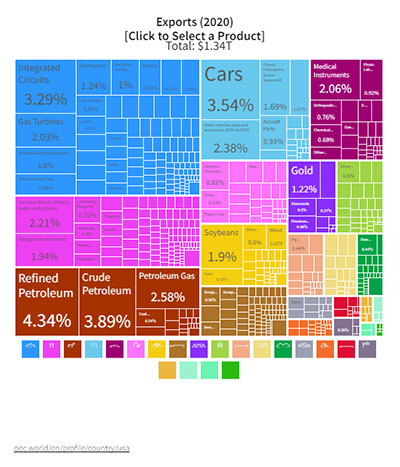
Agricultures' Share of U.S. Exports
Agriculture is a major contributor to what the U.S. exports. Use this interactive OEC hisorical export data website to learn about what the U.S. exports annually.
Questions
Looking at the Exports cube, click on the small icons under the cube to determine what products come from agriculture. Keep in mind that forestry products are also part of agriculture.The practice of producing trees in a managed setting is called silviculture.
- What percentage of exports would you estimate came from agriculture in 2010? How about 2020? Was there an increase or a decrease? What factors may have influenced your findings?
- What were the top five exports overall?

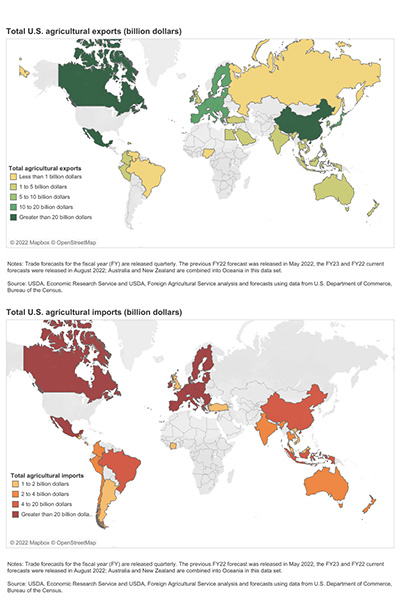
U.S. Agricultural Export and Imports
You can make this map larger and interact with the country export and import totals by viewing the map on the USDA-ERS website
Questions
Using the 2022 maps export and import maps, there are countries where we exported agricultural goods to, but do not import their agricultural goods? What might explain this? There are also countries we import agricultural goods from, but do not export to? What might explain this?
https://www.ers.usda.gov/topics/international-markets-u-s-trade/u-s-agricultural-trade/outlook-for-u-s-agricultural-trade/

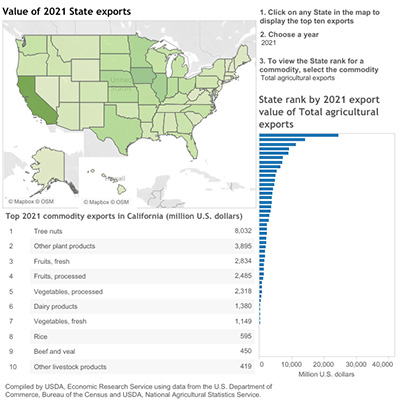
State Agricultural Exports
Annual state contributions to agricultural exports can be explored on the USDA Economic Research Services' Export Interactive Chart. Go to this website to answer the following questions.
Questions
Click on any State in the Map to display the top ten exports from that state. Explore this data by year and commodity. What did you learn about your state and the states that export the most food?
https://www.ers.usda.gov/data-products/state-agricultural-trade-data/annual-state-agricultural-exports/
With 9 billion people to feed in 2050, what will our technologies, practices, and policies be to stave off hunger, enhance our environment, and provide opportunities for society to thrive?

Copied url to clipboard!



